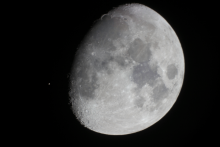Listen to today's episode of StarDate on the web the same day it airs in high-quality streaming audio without any extra ads or announcements. Choose a $8 one-month pass, or listen every day for a year for just $30.
You are here
Moon and Aldebaran
Every star is losing mass. Some are just a lot more serious about it.
An example is Aldebaran, the eye of the bull. The star is below the Moon as night falls, and to the left of the Moon as they set, before dawn.
Aldebaran has passed the end of its normal lifetime, so it’s puffed up to giant proportions — it’s about 45 times the diameter of the Sun. At that size, the gas at its surface is barely held in place by the star’s gravity.
In fact, a lot of it isn’t held in place — it’s blown into space as a high-speed wind. The wind carries away enough gas to make a planet as massive as Earth in about 300,000 years. That’s about 500 times the rate at which the Sun blows gas into space.
Much of the gas condenses to form grains of dust. They’re creating a hazy cloud around Aldebaran. When the star dies, it’ll expel all of its outer layers of gas into space. They’ll be moving much faster than the present-day wind. As they ram into the older gas and dust, they’ll create shock waves and sculpt “fingers” of dense material. The whole mixture of gas and dust will create a colorful bubble that will shine for tens of thousands of years.
That’s also in the future of the Sun. In about five billion years, it will puff up like Aldebaran has. The solar wind will get a lot thicker, surrounding the Sun with its own cocoon of gas and dust. Finally, the Sun will lose its outer layers and create its own bubble — the final outpouring of a star.
Script by Damond Benningfield



